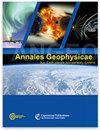低频太阳射电II型爆发及其与太阳周期25上升阶段空间天气事件的联系
IF 1.9
4区 地球科学
Q3 ASTRONOMY & ASTROPHYSICS
引用次数: 0
摘要
摘要第二类太阳射电暴是日冕冲击的特征,因此也是太阳大气层和行星际空间的粒子加速事件。II型射电暴可以作为一种替代物,为即将到来的太阳风暴扰动(如地磁暴和辐射风暴)提供预警,这些扰动可能会进一步导致电离层效应。在这篇文章中,我们通过测量太阳周期 25 中 2021 年 5 月至 2022 年 12 月期间发生的各种等离子体参数,首次报告了对 32 个 II 型爆发的观测结果。我们还利用 TEC 指数(ROTI)从电离层总电子含量(TEC)增强的角度进一步评估了与之伴随的空间天气事件。在这项研究中,我们发现在日心距离∼1-2 R⊙处,冲击速度和阿尔弗韦恩速度的范围分别为504-1282和368-826 km-1。在上述日心距离下,阿尔弗芬马赫数为 1.2≤MA≤1.8。此外,测得的磁场强度与之前的报告一致,遵循单幂律 B(r)=6.07r-3.96G 。根据目前的分析,发现 32 个 II 型爆发中有 19 个与无线电停电和极盖吸收事件等直接空间天气事件有关,是空间天气破坏的强烈迹象。表明电离层不规则的 ROTI 增强与 GOES X 射线耀斑密切相关,而 GOES X 射线耀斑与所记录的 II 型射电暴有关。ROTI 的昼夜变化与相关耀斑类别的强度成正比,相应的纵向变化归因于经度差异。这篇文章表明,由于 II 型爆发与空间气象灾害有关,了解 II 型爆发的各种物理参数有助于预测和预报空间气象。本文章由计算机程序翻译,如有差异,请以英文原文为准。
Low-frequency solar radio type II bursts and their association with space weather events during the ascending phase of solar cycle 25
Abstract. Type II solar radio bursts are signatures of the coronal shocks and, therefore, particle acceleration events in the solar atmosphere and interplanetary space. Type II bursts can serve as a proxy to provide early warnings of incoming solar storm disturbances, such as geomagnetic storms and radiation storms, which may further lead to ionospheric effects. In this article, we report the first observation of 32 type II bursts by measuring various plasma parameters that occurred between May 2021 and December 2022 in solar cycle 25. We further evaluated their accompanying space weather events in terms of ionospheric total electron content (TEC) enhancement using the rate of TEC index (ROTI). In this study, we find that at heliocentric distance ∼1–2 R⊙, the shock and the Alfvén speeds are in the range 504–1282 and 368–826 km−1, respectively. The Alfvén Mach number is of the order of 1.2≤MA≤1.8 at the above-mentioned heliocentric distance. In addition, the measured magnetic field strength is consistent with the earlier reports and follows a single power law B(r)=6.07r-3.96G. Based on the current analysis, it is found that 19 out of 32 type II bursts are associated with immediate space weather events in terms of radio blackouts and polar cap absorption events, making them strong indications of space weather disruption. The ROTI enhancements, which indicate ionospheric irregularities, strongly correlate with GOES X-ray flares, which are associated with the type II radio bursts recorded. The diurnal variability in ROTI is proportional to the strength of the associated flare class, and the corresponding longitudinal variation is attributed to the difference in longitude. This article demonstrates that since type II bursts are connected to space weather hazards, understanding various physical parameters of type II bursts helps to predict and forecast the space weather.
求助全文
通过发布文献求助,成功后即可免费获取论文全文。
去求助
来源期刊

Annales Geophysicae
地学-地球科学综合
CiteScore
4.30
自引率
0.00%
发文量
42
审稿时长
2 months
期刊介绍:
Annales Geophysicae (ANGEO) is a not-for-profit international multi- and inter-disciplinary scientific open-access journal in the field of solar–terrestrial and planetary sciences. ANGEO publishes original articles and short communications (letters) on research of the Sun–Earth system, including the science of space weather, solar–terrestrial plasma physics, the Earth''s ionosphere and atmosphere, the magnetosphere, and the study of planets and planetary systems, the interaction between the different spheres of a planet, and the interaction across the planetary system. Topics range from space weathering, planetary magnetic field, and planetary interior and surface dynamics to the formation and evolution of planetary systems.
 求助内容:
求助内容: 应助结果提醒方式:
应助结果提醒方式:


